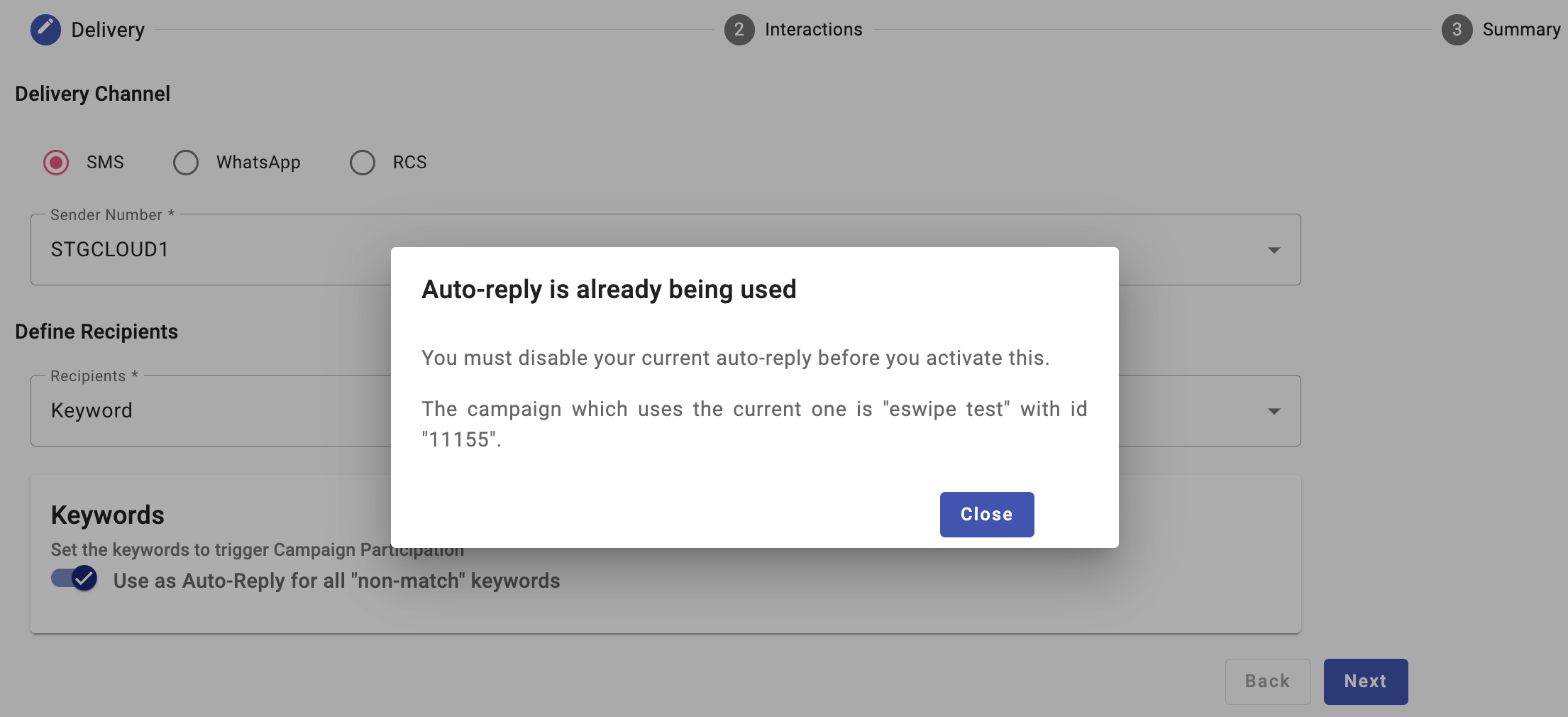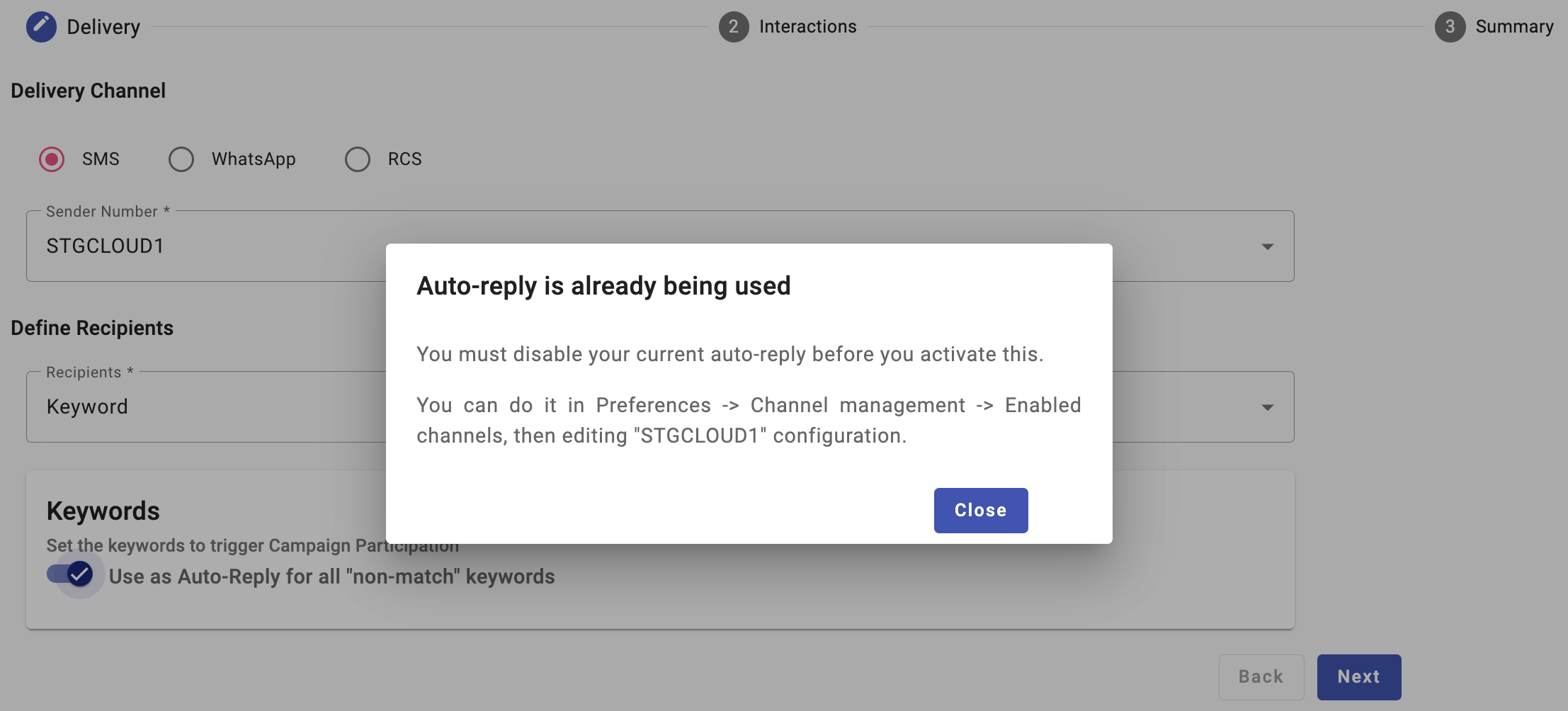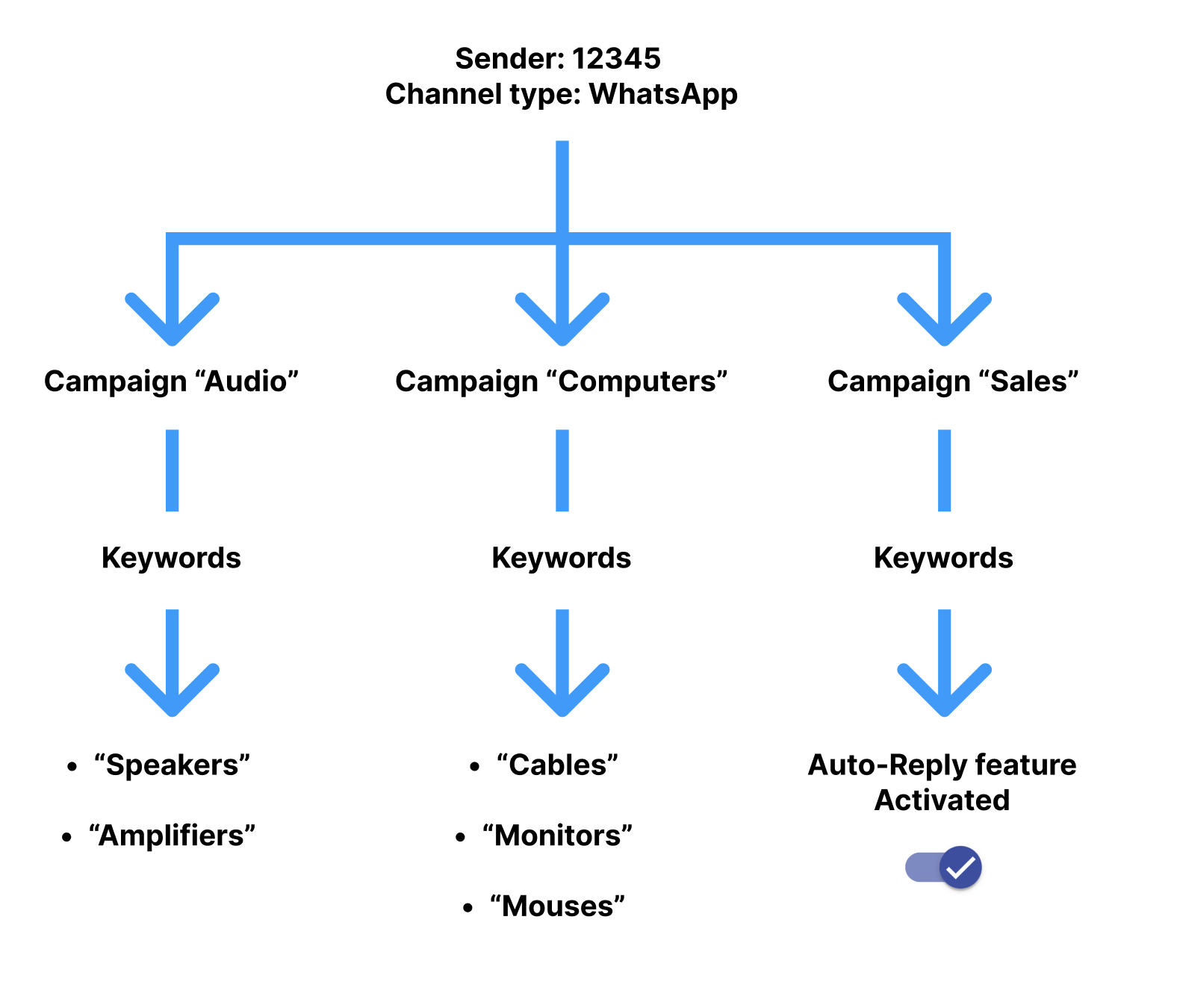Delivery and Triggers
The Delivery step is where you define the interaction channel for the chatbot and the keywords that customers use to invoke it.
Delivery Channel
You define the Delivery Channel and the campaign Recipients in the Delivery step.
Currently, two delivery channels are available for the Chatbot campaign:

For more information on selecting the desired delivery channel, go to the Delivery section.
Define Recipients
To invoke the service, SMS has the two options shown below.

For SMS and WhatsApp as delivery channels, the Keyword option is available. In either case, the platform will provide a Keyword entry section, such as the one shown in the example of the following image.

NOTEEach keyword accepts a maximum of 29 characters.
Up to 30 keywords can be defined to invoke the service.
In case you don't want to enter a keyword, you have the option of using the 'Auto-Reply' feature for all "non-match" keywords. For example, if the subscriber enters any keyword that is not previously defined or configured in campaigns., the chatbot will send the Welcome Message (the first message the user will receive) configured in the Interactions section. That is, this feature can be defined as a pre-start of the campaign in case the subscriber enters any keyword.
To use this feature, slide the toggle to the right but first, you need to consider the following:
-
if another campaign has activated the 'Auto-Reply' function with the same sender number and channel type, you won't be able to use this feature. To use it, you need to disable the 'Auto-Reply' from the campaign that is already being used.
To find out what type of campaign is already using the 'Auto-Reply' function, slide the toggle to the right and a pop-up message will be displayed notifying you of the campaign name and its ID.

-
If a sender number is already activated by the 'Auto-Reply Message' function, you won't be able to use the 'Auto-Reply' function. To use it, you need to disable the 'Auto-Reply Message' by editing the sender number from the Sender Number Configuration (Channel Management tab) located in the Preferences section.
To find out what sender number is already using the 'Auto-Reply Message' function, slide the toggle to the right and a pop-up message will be displayed notifying you of the sender number.

Key Points to Keep in Mind When Setting Up Keywords
Therefore, the setup consists of,
- Select the service channel through the radio buttons
- Select the number for SMS. In the case of WhatsApp, the WhatsApp account will be the de facto option.
- Select the API Endpoint (available for SMS), Keyword(s) accordingly (available for SMS and WhatsApp) or 'Auto-Reply' function.
- Enter the Keyword(s) if you want to set the Keywords to trigger campaign participation.
- Select Next.
The API Endpoint option forgoes the need to define the Keyword(s) in this step but keywords represent the method in all instances to invoke the chatbot.
Keyword Configuration Considerations
Here are some key points to consider when planning to set up multiple chatbot campaigns using the same sender ID and channel type. These points depend on how you configure keywords for each campaign:
- Auto-Reply and Keyword Conflicts: Enabling "Auto-Reply" feature, any incoming message or keyword will trigger the chatbot. This means you can't activate "Auto-Reply" in a second campaign using the same channel along with the sender ID.
- Specifying Keywords for Activation: Instead of "Auto-Reply," you can define specific keywords that trigger the chatbot. End users can then initiate the communication with the chatbot by sending one of these specific keywords.
- Auto-Reply vs. Keyword Activation: The "Auto-Reply" feature allows any keyword to trigger the chatbot. If this option is already used by another chatbot campaign, you'll need to define specific keywords to trigger the chatbot you are setting up. That is, If the end user enters a keyword other than those specified, they will be redirected to the chatbot that has the "Auto Reply" option enabled.
In this example, three chatbot-type campaigns—named "Audio," "Sales," and "Computers"—were configured with the same sender ID ("12345") and channel type (WhatsApp).
- Audio Campaign: This campaign is configured with two specific keywords:
"Speakers"and"Amplifiers". When the end user enters any of these keywords will trigger the chatbot associated with this campaign. - Computers Campaign: This campaign is linked to three specific keywords:
"Cables","Monitors", and"Mouses". When the end user enters any of these keywords will trigger the chatbot associated with this campaign. - Sales Campaign: This campaign was set up with the "Auto-Reply" option enabled. This means it does not require specific keywords to activate. Any keyword that is not matched with the other two campaigns ("Audio" and "Computers") will trigger this chatbot.

The interaction process is visualized in the diagram. Depending on the keyword entered by the end user, they will be directed to the corresponding chatbot. For instance, if an end-user types a keyword other than "Speakers", "Amplifiers", "Cables", "Monitors", or "Mouses" they will automatically be redirected to the chatbot campaign named "Sales". This setup ensures that each chatbot campaign captures only its targeted keywords, while all other inputs default to the "Sales" campaign due to its broad "Auto-Reply" setting.

Updated 4 months ago
